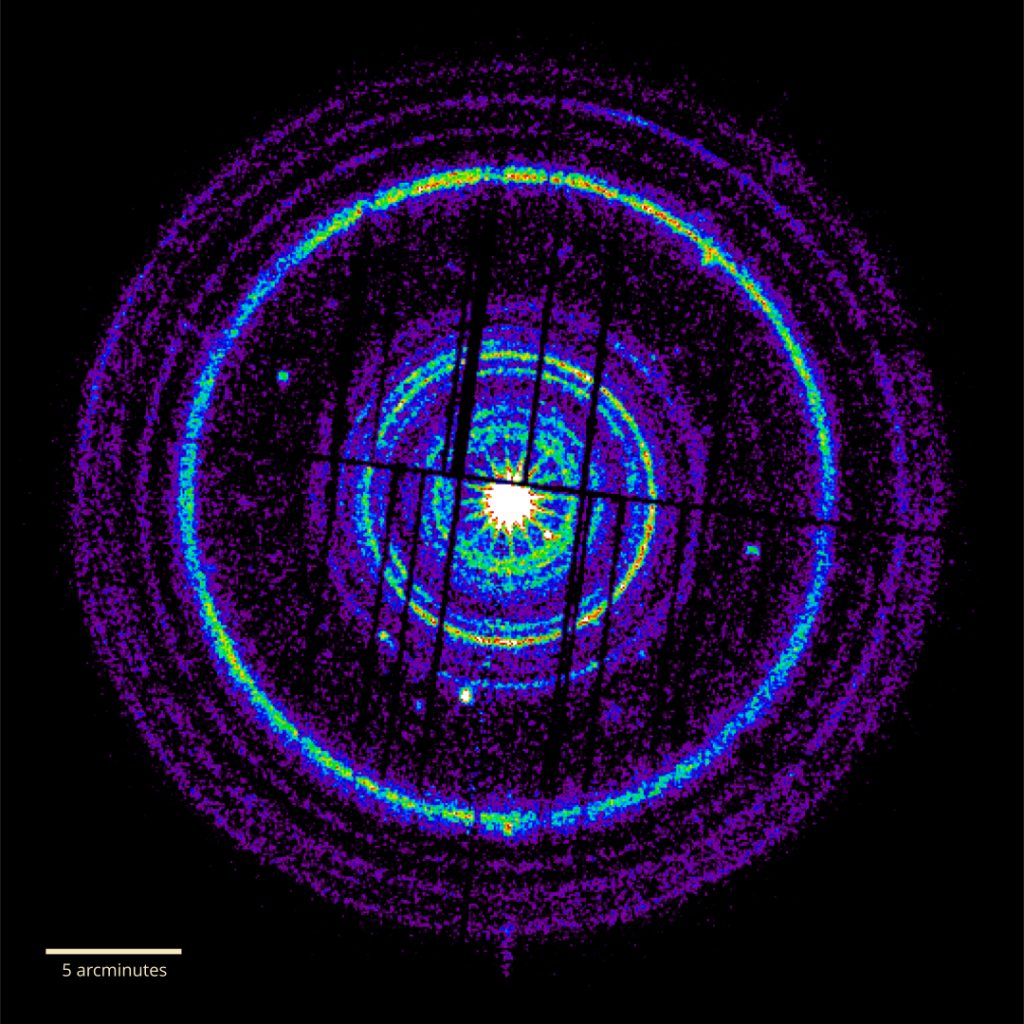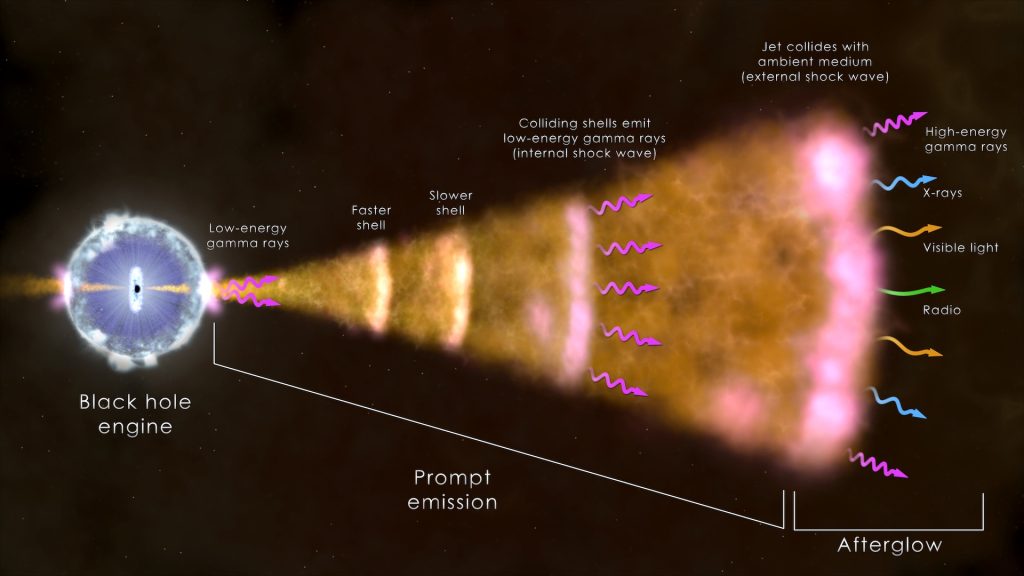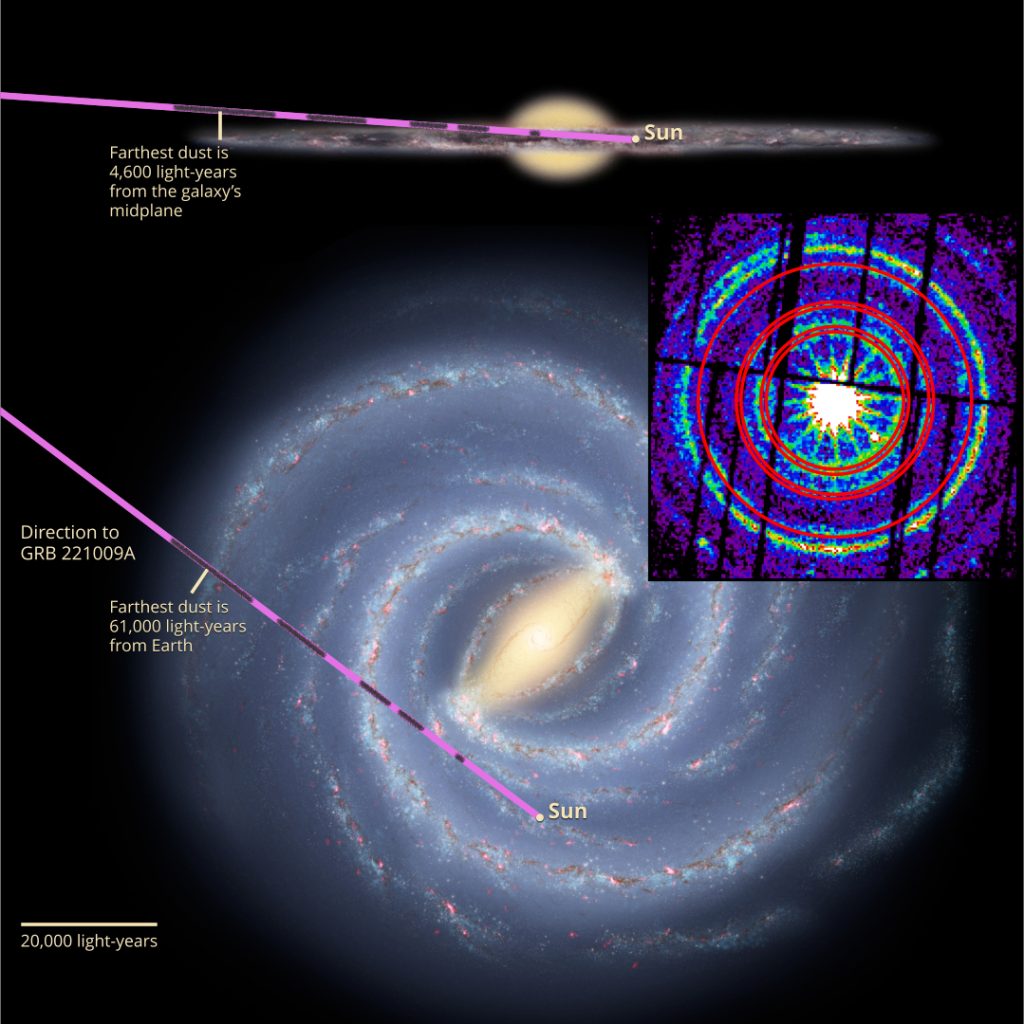Phenomenal space explosion astonishes Leicester researchers and shines a light on our own galaxy
Scientists from across the world have today revealed their analyses of the brightest gamma-ray burst ever detected.
This exceptional event, nicknamed the BOAT (Brightest Of All Time), was discovered by NASA’s Fermi and Swift satellites last October, and University of Leicester researchers have played crucial roles in unlocking its secrets.
When a star much more massive than the Sun runs out of fuel, its core collapses and forms a black hole. As matter swirls toward the black hole, some of it escapes in the form of two powerful jets that rush outward at almost the speed of light in opposite directions, as shown in this animation. Typically jets from collapsing stars produce gamma rays for many seconds to minutes.
Credit: NASA’s Goddard Space Flight Center/Chris Smith (KBRwyle)
Gamma-ray bursts, or GRBs, are the most powerful explosions in the universe, and this event, officially named GRB 221009A, is at least 10 times brighter than anything NASA’s Swift mission has seen before.
Analyses including, investigations by a team of scientists at the University of Leicester, were revealed at a meeting of the American Astronomical Society (AAS) High Energy Astrophysics Division in Hawaii, and the Astrophysical Journal Letters is publishing a special issue of papers dedicated to this single event.
University of Leicester X-ray astronomer, Dr Phil Evans, leads the University of Leicester’s involvement in Swift. He said: “We were really lucky to see something like this – we estimate that events this bright occur roughly once every thousand years!”
He continued: “By studying the evolution of this astonishingly bright GRB in great detail, we can learn a lot about the physics of a blast wave.
“Just like slow-mo cameras reveal details about movement, breaking our data into small time pieces allows us to see how the GRB changes and learn more.”
At 1:16 pm (GMT) on October 9th, 2022, the Fermi satellite detected the initial occurrence of the GRB. Although the satellite has the capability to detect various GRBs, it cannot provide precise information about the location of the explosion.
X-rays from the initial flash of GRB 221009A could be detected for weeks as dust in our galaxy scattered the light back to us. This resulted in the appearance of an extraordinary set of expanding rings. Images captured over 12 days by the X-ray Telescope aboard NASA’s Neil Gehrels Swift Observatory, shown here in arbitrary colors, were combined to make this movie.
Credit: NASA/Swift/A. Beardmore (University of Leicester)
Regrettably, at the time of the incident, the Neil Gehrels Swift Observatory, specifically designed to study GRBs, was unable to observe it due to the Earth obstructing its view. Nevertheless, 55 minutes later, when the Swift satellite’s orbit allowed it to have a clear view of the GRB, its independent GRB systems successfully detected it.
“This was the first indication that this was an unusual event,” explains Dr Kim Page, a member of the Swift team at the University of Leicester, “Swift simply doesn’t trigger on GRBs an hour old! In fact, at first, we thought this must be some other event, an explosion in our own galaxy, for example.”
In a stunning discovery, scientists using the Swift observatory have witnessed a rare and extraordinary GRB nearly 2 billion light years away.
The early data collected by the Swift observatory showed that the GRB was at least 10 times brighter than any other GRB that Swift had ever seen. The X-ray telescope had to remain in a special operating mode to collect data rapidly, without creating images. However, Dr Andy Beadmore, a member of the Swift Team at the University of Leicester, noticed evidence that this explosion was revealing new, unknown structures in our own galaxy. He quickly requested that Swift change operating modes to take an image, which revealed a beautiful “bullseye” structure in the data.

The XMM-Newton X-ray space observatory, which the University of Leicester supplied a set of three X-ray CCD cameras, captured 20 dust rings, 19 of which are shown here in arbitrary colours. The image merges observations made two and five days after GRB 221009A erupted. Dark stripes indicate gaps between the detectors. A detailed analysis shows that the widest ring visible here, comparable to the apparent size of a full moon, came from dust clouds located about 1,300 light-years away. The innermost ring arose from dust at a distance of 61,000 light-years – on the other side of our galaxy. GRB221009A is only the seventh gamma-ray burst to display X-ray rings, and it triples the number of rings previously seen around a GRB.
Credit: ESA/XMM-Newton/M. Rigoselli (INAF)
He explained: “These patterns are not just beautiful but are also useful scientifically. We’re seeing a significant amount of dust in our galaxy being lit up by the intense burst of light from the GRB – two billion light years away – like a torch shining through a cloud. This lets us study its nature and composition which was found to extend to large distances from the Sun.”
Dr Phil Evans added: “Even after 18 years of operation, Swift can still surprise us with something unexpected, awesome, and scientifically powerful, and it can still challenge us – those dust rings may look pretty but they gave us some headaches, they really complicated the data analysis! Even with those complications, though, this event gives us an opportunity to study a GRB in unprecedented detail.”
Dr Beardmore explained: “The brightness of this GRB means that we can collect much better data than normal, and so move beyond simple models of the GRB physics that we normally use – they just can’t explain these data.”
Gamma ray bursts are the most violent explosions in the universe, releasing more energy than the Sun would in 10 billion years. These outbursts result from cataclysmic supernova explosions as massive stars die; under the right conditions these explosions can also yield a gamma-ray burst. The first GRB was discovered in the late 1960s by a satellite looking for Soviet violations of the nuclear test ban treaty, and since then thousands have been seen by different satellites, but there is still much to learn.

Credit: NASA’s Goddard Space Flight Center
Dr Kim Page continued: “GRBs are intrinsically bright, but also usually a long way away. GRB 221009A is both a powerful GRB in its own right, and comparatively close to Earth at ‘only’ about 2 billion light years.”
This has allowed Swift to observe it for much longer than normal, checking in on it daily for 70 days until it moved behind the Sun.
Dr Evans added: “Then there’s the beautiful dust halo that Andy discovered. This is caused by massive clouds of dust in our galaxy — but it’s the light from the GRB, around two billion light years away — that’s actually revealed those clouds to us. Now, we can measure their distance and their composition using this GRB ‘backlight’.
“This discovery is a testament to the power of careful observation and the potential of serendipitous discoveries. I’m thrilled that our team was able to contribute to our understanding of the universe in such a meaningful way.”

This illustration shows the locations of the dust layers associated with the five smallest X-ray rings (inset, circled) from the BOAT GRB. Our Milky Way galaxy is shown in side (top) and plan views. The thick line shows the direction to the burst, and dark patches within it represent the dust layers responsible for producing the X-ray rings. The smallest ring corresponds to the most distant dust, located about 61,000 light-years away from the Sun and 4,600 light-years above the galaxy’s midplane.
Credit: NASA’s Goddard Space Flight Center, JPL-Caltech, and ESA/XMM-Newton/M. Rigoselli (INAF)
In recent weeks the GRB has re-emerged from behind the Sun and is, amazingly, still bright enough for Swift to detect, and so the study of the “BOAT”, this remarkable one-in-millennium event, continues.
For full details of the University of Leicester paper on GRB 221009A visit: https://arxiv.org/abs/2302.03642. To find out more information about the University of Leicester visit: www.le.ac.uk


